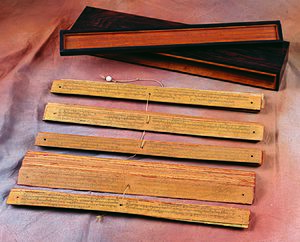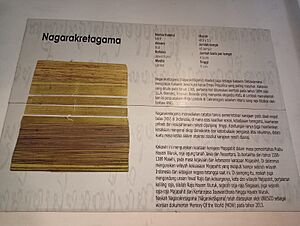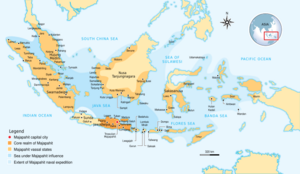Nagarakretagama facts for kids

The Nagarakretagama is a very old Old Javanese poem. It was written to praise Hayam Wuruk, a king of the powerful Majapahit Empire in Java. A poet named Mpu Prapanca wrote it in 1365. The Nagarakretagama tells us a lot about the Majapahit Empire when it was at its strongest. It describes temples, palaces, and important ceremonies, showing how important Hinduism and Buddhism were in the empire.
Contents
The Nagarakretagama Manuscript

In 1894, the Dutch East Indies army went to Lombok. They took many valuable items, including this special manuscript, as war treasures. The first Western expert to study the manuscript was Jan Laurens Andries Brandes, a Dutch language expert. He helped save many old books from being burned during the fighting. Many Dutch scholars then worked together to translate the poem.
The manuscript is written on lontar leaves, which are a type of palm leaf. For a long time, it was kept in a library at Leiden University in the Netherlands.
After it was translated in the early 1900s, the Nagarakretagama became a big inspiration for Indonesia's fight for independence. It reminded people of Indonesia's glorious past.
In 1970, the manuscript was given back to Indonesia during a visit by President Suharto to the Netherlands. Today, you can find it at the National Library of Indonesia. In 2008, UNESCO recognized the Nagarakretagama as an important part of the "Memory of the World" program.
Majapahit's Vast Empire
Historians have studied the poem to learn about the history of the Majapahit Empire. In some parts of the poem, the poet Prapanca lists many places that were part of Majapahit's influence. These places are now part of modern Indonesia. Prapanca said these areas were either directly controlled by Majapahit or were its close allies.
The poem mentions lands on Sumatra, like Jambi and Palembang. It also lists places on Borneo, such as Brunei and Banjarmasin. Even areas in the Malay Peninsula (like Singapore, called Tumasik back then) and islands east of Java, like Bali and Lombok, are mentioned. This shows how far Majapahit's power reached.
The Majapahit Capital City
The manuscript gives us a detailed picture of the capital city of Majapahit. The royal palace was surrounded by a strong, tall wall made of red brick. There was a guard post nearby. The main entrance to the palace was on the north side, with huge, decorated iron doors.
Outside the north gate, there was a long building where important people met once a year. There was also a market and a sacred crossroads. Inside the north gate, there was a courtyard with religious buildings. On the west side, there were pavilions with canals where people could bathe.
Further inside, there were rows of houses for palace servants. The king's own living area was very grand, with decorated brick bases, beautifully carved wooden pillars, and a roof with clay ornaments. Outside the palace, there were homes for priests and other important people. Even further away, separated by open fields, were other royal homes, including that of the chief minister, Gajah Mada.
Royal Ceremonies and Traditions
Prapanca also wrote about the king's religious ceremonies. He described King Hayam Wuruk visiting the Candi Singhasari to honor his great-grandfather, Kertanegara. He also visited another place to worship Ken Arok, who founded the Singhasari kingdom.
The poem tells us about a special ceremony called sraddha, which was done to honor the soul of someone who had passed away. Prapanca described the ceremony for the Queen Grandmother, Gayatri Rajapatni, who had died twelve years earlier. During this ceremony, special thrones were set up, and priests placed a flower statue that represented the Queen Grandmother's soul.
The ceremony lasted for seven days and included colorful parades. Everything was done to please the Queen Grandmother's soul, hoping she would bless her descendants and their rule. After this, the king ordered a new shrine to be built for the Queen Grandmother, where she was honored as the goddess Prajnaparamita.
Important People and Beliefs
The Nagarakretagama was written to show great respect and admiration for King Hayam Wuruk. Prapanca often described the king and his family as having divine, or god-like, qualities. It seems Prapanca wrote this poem after he retired from the court, so it was his own personal work.
One important tradition of the Majapahit royal family was the "royal walkabout." This meant they would travel around the empire, visiting important places and honoring their ancestors. The poem also mentions the death of Hayam Wuruk's most trusted advisor, Gajah Mada.
The Queen Grandmother Rajapatni was very important in Prapanca's poem. She was called the "eminent protector of the world." Rajapatni was the mother of the Majapahit kingdom because she was the daughter of Kertanegara (the last king of Singhasari) and the wife of Raden Wijaya (who founded Majapahit). She was seen as a protector and was believed to embody the goddess Prajnaparamita, the Goddess of Wisdom in Mahayana Buddhism.
The poem describes Kertanegara as a strong Buddhist. After his death, he was seen as a god in three forms: a splendid Jina (a Buddhist figure), an Ardhanarishvara (a Hindu god), and a powerful Shiva-Buddha. This idea of Shiva-Buddha shows how the Javanese people combined Hinduism and Buddhism into one belief, seeing them as different paths to the same truth. This idea is also found in another old Javanese poem, the Kakawin Sutasoma, which has the famous motto "Bhinneka Tunggal Ika" (Unity in Diversity).
See also
- Candi of Indonesia
- Indonesian Esoteric Buddhism
- Javanese culture
- Javanese historical texts
- Kakawin
- Kakawin Sutasoma
- Kejawèn
- Pararaton


